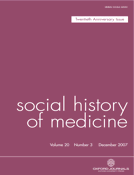-
Views
-
Cite
Cite
Jacqueline H. Wolf, Infant Mortality: A Continuing Social Problem, Social History of Medicine, Volume 20, Issue 3, December 2007, Pages 628–629, https://doi.org/10.1093/shm/hkm092
Close - Share Icon Share
Extract
In 1906, Sir George Newman, a British physician and pioneer in the fields of public and child health, published Infant Mortality: A Social Problem. The first book-length publication to address the issue, Newman's work not only closely examined the complex context of infant death but also offered a series of preventive measures to alleviate what was then 150 infant deaths per 1,000 live births in Britain. This 2006 publication, a series of specially commissioned articles authored by geographers, demographers, epidemiologists and historians, is a centenary tribute to Newman's book, a book that was instrumental in defining infant death as a preventable problem. Infant Mortality: A Continuing Social Problem re-examines the territory studied by Newman and investigates how his proposed solutions influenced all public health work touching infant and child health.
The book is divided into three parts. The first two chapters are biographies of Newman's life and work. The next seven chapters are a re-examination of the social and demographic conditions of his world employing abundant data and techniques unavailable to Newman. The last three chapters are a study of the steady fall in infant mortality in the 100 years since the volume appeared and an assessment of how this plunge affected medical, social and political attitudes. When Newman's book appeared, the infant mortality rate in England and Wales had been static for half a century even though premature death in other categories had fallen precipitously. Newman thought he knew why. As the title of his book implied, he believed infant mortality was not a medical but a social problem, begging for social solutions. He contended that because babies were wholly dependent on others for care, the infant mortality rate suggested the state of everyone's well-being. His argument ensured that infant mortality would become the universal measure of societal health.




